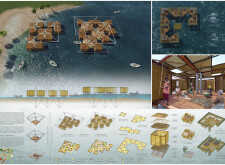5 key facts about this project
### Project Overview
Located on the coast of Malawi, the Water-Lily Community is a community-oriented architectural design that emphasizes sustainable living and interaction with the local aquatic environment. The project aims to create adaptable living spaces that respond to fluctuations in water levels, thereby addressing the challenges posed by climate change and flooding in the region.
### Spatial Strategy
The layout of the community features modular living units that are versatile, allowing for a range of configurations suited to varying family sizes and social gatherings. Shared public amenities, including gardens and community kitchens, facilitate social interaction while maintaining accessible private areas for residents. Central courtyards serve as focal points for communal activities, reinforcing community bonds through intentional spatial organization.
### Material Selection
The material choices in the Water-Lily Community reflect a commitment to sustainability and local resources. Timber and bamboo are prominently used for structural elements and wall construction, emphasizing renewable materials that support local craftsmanship. Additionally, repurposed plastics are integrated into structural components, showcasing innovative strategies for waste management. Treated wood is employed for decks and structural beams, ensuring durability against the humid, aquatic environment. These materials align with the project’s focus on minimizing ecological impact while fostering a welcoming atmosphere.



















































